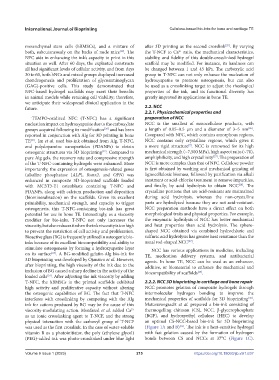Page 223 - IJB-9-1
P. 223
International Journal of Bioprinting Cellulose-based bio-inks for bone and cartilage TE
mesenchymal stem cells (hBMSCs), and a mixture of after 3D printing as the second crosslink . By varying
[25]
both, subcutaneously on the backs of nude mice . The the T-NCF to Ca ratio, the mechanical characteristics,
2+
[19]
NFC aids in enhancing the ink’s capacity to print in this stability, and fidelity of this double-crosslinked hydrogel
situation as well. After 60 days, the explanted constructs scaffold may be modified. For instance, its hardness can
all had significant levels of cellular activity, and from days be changed between 1 and 45 kPa. The carboxylic acid
30 to 60, both hNCs and mixed groups displayed increased group in T-NFC can not only enhance the nucleation of
chondrogenesis and proliferation of glycosaminoglycan hydroxyapatite to promote osteogenesis, but can also
(GAG)-positive cells. This study demonstrated that be used as a crosslinking target to adjust the rheological
NFC-based hydrogel scaffolds may exert their benefits properties of the ink, and its functional diversity has
in animal models while retaining cell viability; therefore, greatly improved its applications in bone TE.
we anticipate their widespread clinical application in the
future. 2.2. NCC
2.2.1. Physicochemical properties and
TEMPO-oxidized NFC (T-NFC) has a significant preparation of NCC
nucleation impact on hydroxyapatite due to the carboxylate NCC is the smallest of nanocellulose products, with
[26]
groups acquired following its modification and has been a length of 0.05–0.5 µm and a diameter of 3–5 nm .
[20]
reported in conjunction with Alg for 3D printing in bone Compared with NFC, which contains amorphous regions,
TE . Im et al. used bio-ink obtained from Alg, T-NFC, NCC contains only crystalline regions, which gives it
[21]
[7]
and polydopamine nanoparticles (PDANPs) to obtain a more rigid structure . NCC is renowned for its high
osteogenic structures via 3D bioprinting . Compared to mechanical strength (~7,500 MPa), high aspect ratio (~70),
[22]
pure Alg gels, the recovery rate and compressive strength amphiphilicity, and high crystallinity . The preparation of
[27]
of the T-NFC-containing hydrogels were enhanced. More NCC is more complex than that of NFC. Cellulose powder
importantly, the expression of osteogenesis-related genes is first obtained by washing and mechanical grinding of
(alkaline phosphatase [ALP], Runx2, and OPN) was lignocellulosic biomass, followed by purification via alkali
enhanced in composite 3D-bioprinted scaffolds loaded treatment or acid-chlorite treatment to remove impurities,
[28]
with MC3T3-E1 osteoblasts containing T-NFC and and finally, by acid hydrolysis to obtain NCC . The
PDANPs, along with calcium production and deposition crystalline portions that are acid-resistant are maintained
(biomineralization) on the scaffolds. Given its excellent during acid hydrolysis, whereas the non-crystalline
printability, mechanical strength, and capacity to trigger parts are hydrolyzed because they are not acid-resistant.
osteogenesis, this T-NFC-containing bio-ink has great NCC preparation methods have a direct effect on both
potential for use in bone TE. Interestingly, as a viscosity morphological traits and physical properties. For example,
modifier for bio-inks, T-NFC not only increases the the enzymatic hydrolysis of NCC has better mechanical
viscosity, but also reduces it when the ink viscosity is too high and heat properties than acid hydrolysis. The sphere-
to prevent the restriction of cell activity and proliferation. shaped NCC obtained via combined hydrochloric and
Bioactive glass (BG) is frequently utilized in osteogenic bio- sulfuric acid hydrolysis has greater heat resistance than the
inks because of its excellent biocompatibility and ability to usual rod-shaped NCC .
[27]
stimulate osteogenesis by forming a hydroxyapatite layer NCC has various applications in medicine, including
on its surface . A BG-modified gelatin-Alg bio-ink for TE, medication delivery systems, and antibacterial
[23]
3D bioprinting was developed by Ojansivu et al. However, agents. In bone TE, NCC can be used as an enhancer,
after bioprinting, the high viscosity of the ink due to the additive, or biomaterial to enhance the mechanical and
inclusion of BG caused a sharp decline in the activity of the biocompatibility of scaffolds .
[29]
loaded cells . After adjusting the ink viscosity by adding
[24]
T-NFC, the hBMSCs in the printed scaffolds exhibited 2.2.2. NCC 3D bioprinting in cartilage and bone repair
high activity and proliferative capacity without altering NCC promotes gelation of composite hydrogels through
the osteogenic capabilities of BG. The fact that T-NFC intermolecular hydrogen bonding to improve the
[30]
interferes with crosslinking by competing with the Alg mechanical properties of scaffolds for 3D bioprinting .
ink for cations produced by BG may be the cause of this Maturavongsadit et al. prepared a bio-ink consisting of
viscosity-modulating action. Monfared et al. added Ca thermogelling chitosan (CS), NCC, β-glycerophosphate
2+
as an ionic crosslinking agent to T-NCF, and the strong (BGP), and hydroxyethyl cellulose (HEC) to develop
physical interaction with the carboxyl group of T-NCF an optimal CS-NCC-based bio-ink for 3D bioprinting
was used as the first crosslink. In the case of water-soluble (Figure 1A and B) . The ink is a heat-sensitive hydrogel
[31]
vitamin B as a photoinitiator, the poly (ethylene glycol) with fast gelation caused by the formation of hydrogen
(PEG)-added ink was photo-crosslinked under blue light bonds between CS and NCCs at 37°C (Figure 1C).
V
Volume 9 Issue 1 (2023)olume 9 Issue 1 (2023) 215 https://doi.org/10.18063/ijb.v9i1.637

